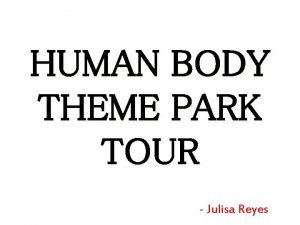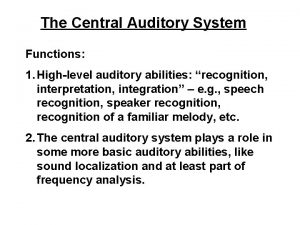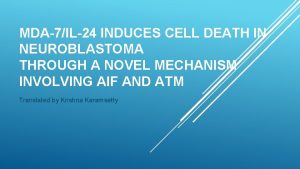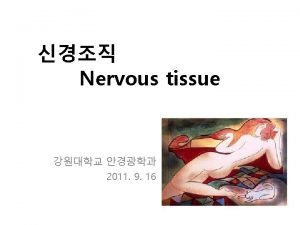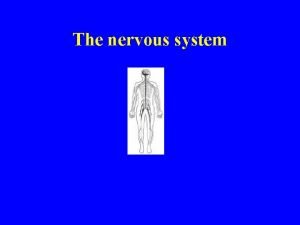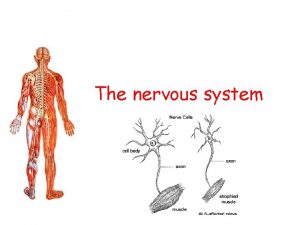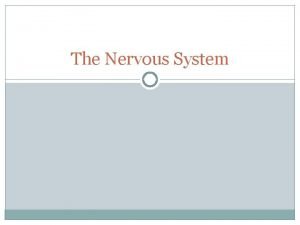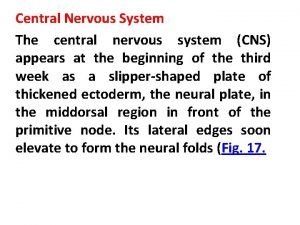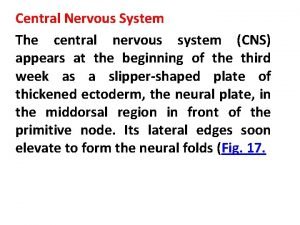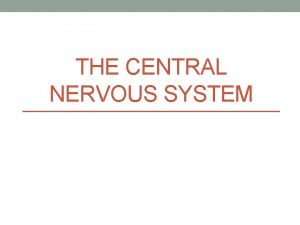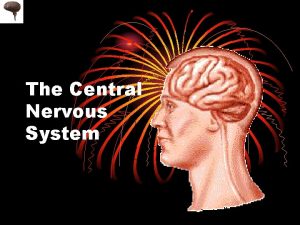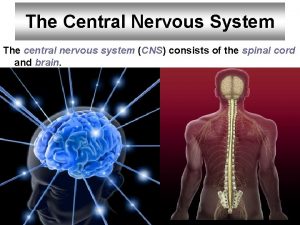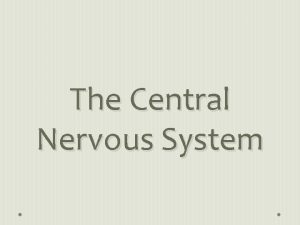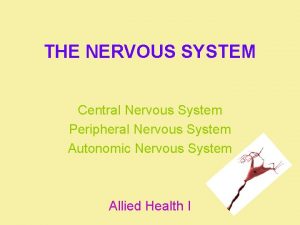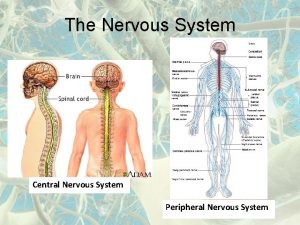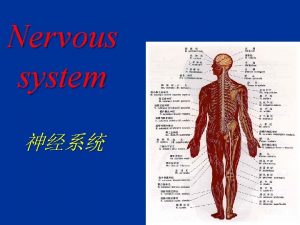Nervous System Nervous System Nervous system Central Nervous























- Slides: 23

Nervous System

Nervous System Nervous system Central Nervous System Peripheral Nervous System Brain Spinal Cord Sensory Nerves Somatic Motor Nerves Automatic

Function of the nervous system: • Controls and coordinates functions throughout the body

The Neuron – nerve cell nucleus Axon Cell Dendrite Cell Axon Myelin body – sheath carries ––reception contains –the insulating nerve of thenerve cell impulse membrane nucleus impulses away terminals body Myelin from the other cell body cells sheath nodes axon dendrites

Nerve Impulse • Moves like the flow of electrons through a wire

Nerve Impulse • 2 Phases: – resting potential – the neuron membrane is positive outside and negative inside; the sodium-potassium pump moves sodium out while bringing in potassium – action potential – negative outside and positive inside; as the nerve impulse moves along the neuron from the dendrites through the cell body to the axon, polarity changes across neuron membrane;


Practice A • Label the indicated parts. B C

Synapse • location where nerve impulse moves from one neuron to the next • Tiny gap where the nerve impulse is transferred by chemical neurotransmitters

Divisions of the nervous system – Central nervous system (CNS) – brain & spinal cord – Peripheral nervous system (PNS) – nerves to other parts of the body • • Sensory – provides brain with information from the senses Motor – carries information from the CNS to the muscles & glands, divided into somatic nervous system (voluntary movement) and automatic nervous system (involuntary movement)

The Brain • Controls and coordinate body activities • Meninges – tough covering over the brain & spinal cord • Cerebrum (gray matter) – controls voluntary activities, intelligence • Cerebellum – back of skull; coordinates & balances actions of muscles & body

The Brain • Brainstem – pons and medulla oblongata – regulates the flow of information between the brain & body – controls blood pressure, heart rate, breathing, & swallowing

The Brain • Thalamus – receives messages from the senses & sends them to cerebrum • Hypothalamus – – control center that detects and analyzes hunger, thirst, fatigue, anger, & body temperature – controls and coordinates nervous & endocrine systems

thalamus cerebrum hypothalamus midbrain pons Medulla oblongata cerebellum

Practice • Which part of my brain…?

Reflex Arc • Quick automatic response to stimulation like blinking or sneezing • Nerve impulse goes to the spinal cord & back to muscles without passing through the brain

The Senses • Eye – light passes though the cornea, pupil (opening at the front of the eye) & lens to the retina. – Retina – consists of rods (sensitive to light) & cones (distinguishes color) – Optic nerve – sends messages from the retina to the brain

Vitreous humor Muscle Lens Aqueous humor Cornea Pupil Iris Fovea Optic nerve Blood vessels Retina Ligaments Choroid Sclera

Ear • • • Has 3 tiny bones - hammer, anvil, stirrup Conduct sound vibrations: tympanum, hammer, anvil, stirrup, oval window, cochlea Semicircular canals – three fluid-filled tiny canals, assist in balance

Hammer Stirrup Oval window Anvil Semicircular canals Cochlear nerve Cochlea Bone Auditory canal Tympanum Round window Eustachian tube

Taste buds – on the tongue, detect taste

• Smell – detected by olfactory bulbs in nasal passages • Touch – skin has sensory receptors to temperature, touch, and pain

Drugs that affect the nervous system: • Stimulants – increase actions (heart rate, increase neurotransmitters in brain) – • Include: caffeine, nicotine, cocaine Depressants – decrease activity (heart rate) – Include: marijuana, alcohol
 Neuronal pools
Neuronal pools Nervous
Nervous Nerve cell processes
Nerve cell processes Central and peripheral nervous system
Central and peripheral nervous system Central nervous system amusement park
Central nervous system amusement park Central nervous system diagram
Central nervous system diagram Nervous tissue
Nervous tissue Central and peripheral nervous system
Central and peripheral nervous system Bser aer
Bser aer Central nervous system divisions
Central nervous system divisions Central nervous system for kids
Central nervous system for kids Central nervous sysytem
Central nervous sysytem Nervous system and digestive system
Nervous system and digestive system Endocrine system and nervous system
Endocrine system and nervous system Endo crine gland
Endo crine gland Endocrine system
Endocrine system Chemical messengers of the nervous system
Chemical messengers of the nervous system Phylum nematoda segmentation
Phylum nematoda segmentation The nervous system is made up of
The nervous system is made up of Three basic functions of the nervous system
Three basic functions of the nervous system Learning objectives of nervous system
Learning objectives of nervous system Bipolar neuron function
Bipolar neuron function What is stimuli in nervous system
What is stimuli in nervous system Neuron bundle
Neuron bundle




